King Henry VI 1422-1461
English Costume by Dion Clayton Calthrop

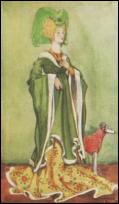 This costume history information consists of Pages 176-197 of the chapter on the 15th century dress in the 39 YEAR REIGN era of Henry The Sixth 1422-1461 and taken from English Costume by Dion Clayton Calthrop.
This costume history information consists of Pages 176-197 of the chapter on the 15th century dress in the 39 YEAR REIGN era of Henry The Sixth 1422-1461 and taken from English Costume by Dion Clayton Calthrop.
The 36 page section consists of a text copy of the book ENGLISH COSTUME PAINTED & DESCRIBED BY DION CLAYTON CALTHROP. Visuals, drawings and painted fashion plates in the book have a charm of their own and are shown amid the text. The book covers both male and female dress history of over 700 years spanning the era 1066-1830.
This page is about dress in the reign of King Henry The Sixth 1422-1461. The images and details are a good resource for costuming Shakespeare's stage plays of the Plantagenet era.
For the Introduction to this book see this introduction written by Dion Clayton Calthrop. I have adjusted the images so they can be used for colouring worksheets where pupils add some costume/society facts.
My comments are in italics.
HENRY THE SIXTH
Reigned thirty-nine years: 1422-1461.
Born 1421. Dethroned 1461. Died 1471. Married, 1446, Margaret of Anjou.
THE MEN
What a reign! Was history ever better dressed?
I never waver between the cardboard figures of the great Elizabethan time and this reign as a monument to lavish display, but if any time should beat this for quaintness, colour, and variety, it is the time of Henry VIII.
Look at the scenes and characters to be dressed: John, Duke of Bedford, the Protector, Joan of Arc, Jack Cade, a hundred other people; Crevant, Verneuil, Orleans, London Bridge, Ludlow, St. Albans, and a hundred other historical backgrounds.
Yet, in spite of all this, in spite of the fact that Joan of Arc is one of the world's personalities, it is difficult to pick our people out of the tapestries.
Now, you may have noticed that in trying to recreate a period in your mind certain things immediately swing into your vision: it is difficult to think of the Conquest without the Bayeux tapestry; it is difficult to think of the dawn of the sixteenth century without the dreamy, romantic landscapes which back the figures of Giorgione; and it is not easy to think of these people of the Henry VI period without placing them against conventional tapestry trees, yellow-white castles with red, pepper-pot roofs, grass luxuriant with needlework flowers, and all the other accessories of the art.
The early times are easily imagined in rough surroundings or in open air; knights in armour ride quite comfortably down modern English lanes. Alfred may burn his cakes realistically, and Canute rebuke his courtiers on the beach - these one may see in the round. Elizabeth rides to Tilbury, Charles II casts his horoscope, and George rings the bell, each in their proper atmosphere, but the Dark Ages are dark, not only in modes of thought, but in being ages of grotesque, of ornamentation, of anything but realism.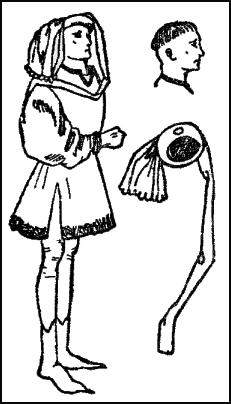
One has, I think, a conventional mind's eye for the times from Edward I to Richard III, from 1272 to 1485, and it is really more easy for a Chinaman to call up a vision of 604 A.D., when Laot-sen, the Chinese philosopher, was born. Laot-sen, the child-old man, he who was born with white hair, lived till he was eighty-one, and, having had five million followers, went up to heaven on a black buffalo. In China things have changed very little: the costume is much the same, the customs are the same, the attitude towards life has not changed. But here the semicivilized, superstitious, rather dirty, fourteenth and fifteenth century person has gone. Scratch a Russian, they say, and you will see a Tartar; do the same office by an Englishman, and you may find a hint of the Renaissance under his skin, but no more. The Middle Ages are dead and dust.
§
Henry VI - Headwear
The Roundlet
We will proceed with that congenial paradox which states that the seat of learning lies in the head, and so discuss the most distinctive costumery of this time, the roundlet.
Now, the roundlet is one of those things which delight the clothes-hunter or the costume expert. It is the natural result of a long series of fashions for the head, and its pedigree is free from any impediment or hindrance; it is the great-grandson of the hood, which is derived from a fold in a cloak, which is the beginning of all things.
I am about to run the risk of displeasure in repeating to some extent what I have already written about the chaperon, the hood, and the other ancestors and descendants of the roundlet.
The Cloak is Born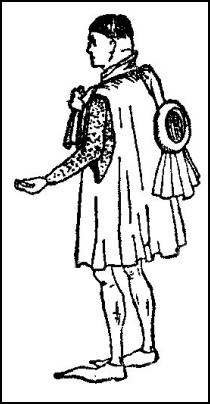
A fashion is born, not made. Necessity is the mother of Art, and Art is the father of Invention. A man must cover his head, and if he has a cloak, it is an easy thing in rain or sunshine to pull the folds of the cloak over his head.
An ingenious fellow in the East has an idea: he takes his 8 feet - or more - of material; he folds it in half, and at about a foot and a half, or some such convenient length, he puts several neat and strong stitches joining one point of the folded material.
When he wraps this garment about him, leaving the sewn point in the centre of his neck at the back, he finds that he has directed the folds of his coat in such a manner as to form a hood, which he may place on or off his head more conveniently than the plain unsewn length of stuff. The morning sun rises on the sands of Sahara and lights upon the first burnoose.
By a simple process in tailoring, some man, who did not care that the peak of his hood should be attached to his cloak, cut his cloth so that the cloak had a hood, the peak of which was separate and so looser, and yet more easy to pull on or off. Now comes a man who was taken by the shape of the hood, but did not require to wear a cloak, so he cut his cloth in such a way that he had a hood and shoulder-cape only.
From this to the man who closed the front of the hood from the neck to the edge of the cape is but a quick and quiet step. By now necessity was satisfied and had given birth to art. Man, having admired his face in the still waters of a pool, seeing how the oval framed in the hood vastly became him, sought to tickle his vanity and win the approbation of the other sex, so, taking some shears, cut the edge of his cape in scallops and leaves. A more dandified fellow, distressed at the success of his brother's plumage, caused the peak of his hood to be made long.
The Liripipe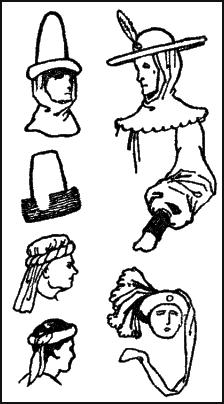
Need one say more? The long peak grew and grew into the preposterous liripipe which hung down the back from the head to the feet. The dandy spirit of another age, seeing that the liripipe can grow no more, and that the shape of the hood is common and not in the true dandiacal spirit, whips off his hood, and, placing the top of his head where his face was, he twists the liripipe about his head, imprisons part of the cape, and, after a fixing twist, slips the liripipe through part of its twined self and lets the end hang down on one side of his face, while the jagged end of the hood rises or falls like a cockscomb on the other. Cockscomb! there's food for discussion in that - fops, beaux, dandies, coxcombs - surely.
I shall not go into the matter of the hood with two peaks, which was not, I take it, a true child of fashion in the direct line, but a mere cousin - a junior branch at that.
As to the dates on this family tree, the vague, mysterious beginnings B.C. - goodness knows when - in a general way the Fall, the Flood, and the First Crusade, until the time of the First Edward; the end of the thirteenth century, when the liripipe budded, the time of the Second Edward; the first third of the fourteenth century, when the liripipe was in full flower, the time of the Third Edward; the middle of the fourteenth century, when the liripipe as a liripipe was dying, the time of the Second Richard; the end of the century, when the chaperon became the twisted cockscomb turban. Then, after that, until the twenty-second year of the fifteenth century, when the roundlet was born - those are the dates.
§
How The Medieval Roundlet Little Round Hat Came About
We have arrived by now, quite naturally, at the roundlet. I left you interested at the last phase of the hood, the chaperon so called, twisted up in a fantastical shape on man's head. You must see that the mere process of tying and retying, twisting, coiling and arranging, was tedious in the extreme, especially in stirring times with the Trumpets sounding in England and France.
Now what more likely for the artist of the tied hood than to puzzle his brains in order to reach a means by which he could get at the effect without so much labour! Enter invention - enter invention and exit art.
With invention, the made-up chaperon sewn so as to look as if it had been tied.
There was the twist round the head, the cockscomb, the hanging piece of liripipe. Again this was to be simplified: the twist made into a smooth roll, the skull to be covered by an ordinary cap attached to the roll, the cockscomb converted into a plain piece of cloth or silk, the liripipe to become broader. And the end of this, a little round hat with a heavily-rolled and stuffed brim, pleated drapery hanging over one side and streamer of broad stuff over the other; just such a hat did these people wear, on their heads or slung over their shoulder, being held in the left hand by means of the streamer.
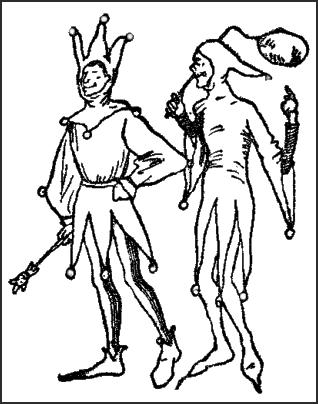 There the honourable family of hood came to a green old age, and was, at the end of the fifteenth century, allowed to retire from the world of fashion, and was given a pension and a home, in which home you may still see it - on the shoulders of the Garter robe. Also it has two more places of honourable distinction - the roundlet is on the Garter robe; the chaperon, with the cut edge, rests as a cockade in the hats of liveried servants, and the minutest member of the family remains in the foreign buttons of honourable Orders.
There the honourable family of hood came to a green old age, and was, at the end of the fifteenth century, allowed to retire from the world of fashion, and was given a pension and a home, in which home you may still see it - on the shoulders of the Garter robe. Also it has two more places of honourable distinction - the roundlet is on the Garter robe; the chaperon, with the cut edge, rests as a cockade in the hats of liveried servants, and the minutest member of the family remains in the foreign buttons of honourable Orders.
We have the roundlet, then, for principal head-gear in this reign, but we must not forget that the hood is not dead; it is out of the strict realms of fashion, but it is now a practical country garment, or is used for riding in towns.
Other Medieval Hats - 1422-1461
There are also other forms of head-wear - tall, conical hats with tall brims of fur, some brims cut or scooped out in places; again, the hood may have a furred edge showing round the face opening; then we see a cap which fits the head, has a long, loose back falling over the neck, and over this is worn a roll or hoop of twisted stuff. Then there is the sugar-loaf hat, like a circus clown's, and there is a broad, flat-brimmed hat with a round top, like Noah's hat in the popular representations of the Ark.
Jester's Three Peaked Hood
Besides these, we have the jester's three-peaked hood and one-peaked hood, the cape of which came, divided into points, to the knees, and had arms with bell sleeves.
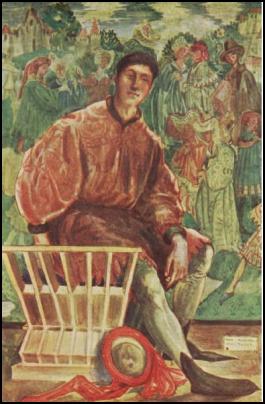 A MAN OF THE TIME OF HENRY VI - 1422-1461
A MAN OF THE TIME OF HENRY VI - 1422-1461
Headwear
His hair is cropped over his ears and has a thick fringe on his forehead. Upon the ground is his roundlet, a hat derived from the twisted chaperon of Richard II's day. This hat is worn to-day, in miniature, on the shoulder of the Garter robes.
Priestly Hair
Let us see what manner of man we have under such hats: almost without exception among the gentlemen we have the priestly hair - that queer, shaved, tonsure-like cut, but without the circular piece cut away from the crown of the head.
C15th Mens Tunics
The cut of the tunic in the body has little variation; it may be longer or shorter, an inch above or an inch below the knee, but it is on one main principle. It is a loose tunic with a wide neck open in front about a couple or three inches; the skirt is full, and may be cut up on one or both sides; it may be edged with fur or some stuff different to the body of the garment, or it may be jagged, either in regular small scoops or in long fringe-like jags. The tunic is always belted very low, giving an odd appearance to the men of this time, as it made them look very short in the leg.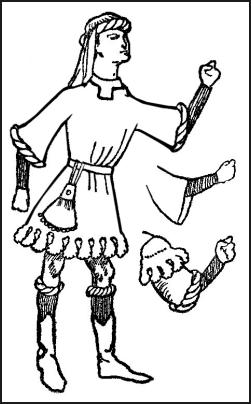
Tunic Sleeves
The great desire for variety is displayed in the forms of sleeve for this tunic: you may have the ordinary balloon sleeve ending in a stuff roll or fur edge for cuff, or you may have a half-sleeve, very wide indeed, like shoulder-capes, and terminated in the same manner as the bottom of the tunics - that is, fur-edged tunic, fur-edged sleeve, and so on, as described; under this shows the tight sleeve of an undergarment, the collar of which shows above the tunic collar at the neck.
The length of these shoulder-cape sleeves varies according to the owner's taste, from small epaulettes to heavy capes below the elbow. There is also a sleeve tight from wrist to below the elbow, and at that point very big and wide, tapering gradually to the shoulder. You will still see one or two high collars rolled over, and there is a distinct continuance of the fashion for long-pointed shoes.
New Overcoat
There is an almost new form of overcoat which is really a tunic of the time, unbelted, and with the sleeves cut out; also one with short, but very full, sleeves, the body very loose; and besides the ordinary forms of square, oblong, and round cloak, there is a circular cloak split up the right side to the base of the biceps, with a round hole in the centre, edged with fur, for the passage of the head.
Rich Velvet Materials
Velvet was in common use for gowns, tunics, and even for bed-clothes, in the place of blankets. It was made in all kinds of beautiful designs, diapered, and raised over a ground of gold or silk, or double-piled, one pile on another of the same colour making the pattern known by the relief.
The massed effect of well-dressed crowds must have been fine and rich in colour - here and there a very rich lady or a magnificent gentleman in pall (the beautiful gold or crimson web, known also as bandekin), the velvets, the silks of marvellous colours, and none too fresh or new.
I think that such a gathering differed most strongly from a gathering of to-day by the fact that one is impressed to-day with the new, almost tinny newness, of the people's clothes, and that these other people were not so extravagant in the number of their dresses as in the quality, so that then one would have seen many old and beautifully-faded velvets and sun-licked silks and rain-improved cloths.
Among all this crowd would pass, in a plain tunic and short shoes, Henry, the ascetic King.
THE WOMEN
One is almost disappointed to find nothing upon the curious subject of horns in 'Sartor Resartus.' Such a flaunting, Jovian spirit, and poetry of abuse as might have been expected from the illustrious and iconoclastic author would have suited me, at this present date, most admirably.
I feel the need of a few thundering German words, or a brass band at the end of my pen, or purple ink in my inkwell, or some fantastic and wholly arresting piece of sensationalism by which to convey to you that you have now stepped into the same world as the Duchess out of 'Alice in Wonderland.'
High Towering Headdresses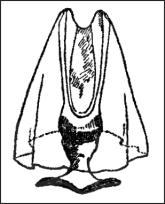
Look out of your window and see upon the flower-enamelled turf a hundred bundles of vanity taking the air. The heads of these ladies are carried very erect, as are all heads bearing weights. The waists of these ladies are apparently under their bosoms; their feet seem to be an ell long.
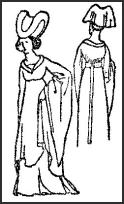 An assembly hour is, after the manner of Lydgate's poem, a dream of delicious faces surmounted by minarets, towers, horns, excrescences of every shape - enormous, fat, heart-shaped erections, covered with rich, falling drapery, or snow-white linen, or gold tissue; gold-wire boxes sewn with pearls and blazing with colours; round, flat-topped caps, from under which girls' hair escapes in a river of colour; crown shapes, circular shapes, mitre shapes, turbans, and shovel-shaped linen erections, wired into place.
An assembly hour is, after the manner of Lydgate's poem, a dream of delicious faces surmounted by minarets, towers, horns, excrescences of every shape - enormous, fat, heart-shaped erections, covered with rich, falling drapery, or snow-white linen, or gold tissue; gold-wire boxes sewn with pearls and blazing with colours; round, flat-topped caps, from under which girls' hair escapes in a river of colour; crown shapes, circular shapes, mitre shapes, turbans, and shovel-shaped linen erections, wired into place.
Oh, my lady, my lady! how did you ever hear the soft speeches of gallantry? How did the gentle whispers of love ever penetrate those bosses of millinery?
And the moralists, among whom Heaven forbid that I should be found, painted lurid pictures for you of hell and purgatory, in which such head-dresses turned into instruments of torture; you lifted your long-fingered, medieval hand and shook the finger with the toad-stone upon it, as if to dispel the poison of their words.
I think it is beyond me to describe in understandable terms the proper contortions of your towered heads, for I have little use for archaic words, for crespine, henk, and jacque, for herygouds with honginde sleeves, for all the blank cartridges of antiquarianism. I cannot convey the triple-curved crown, the ear buttress, the magnet-shaped roll in adequate language, but I can draw them for you.
How to Make A Medieval Headdress
Calthrop's Late Medieval Headdress Pattern Instructions
Popular Medieval Roll Headdresses
I will attempt the most popular of the roll head-dresses and the simpler of the stiff-wired box. Take a roll, stuffed with hemp or tow, of some rich material and twist it into the form of a heart in front and a shape behind, where join the ends, or, better, make a circle or hoop of your rolled stuff and bend it in this way.
Then make a cap that will fit the head and come over the ears, and make it so that this cap shall join the heart-shaped roll at all points and cause it to appear without any open spaces between the head and the roll; the point of the heart in front will be round, and will come over the centre of the face.
By joining cap and roll you will have one complete affair; over this you may brooch a linen wimple or a fine piece of jagged silk. In fact, you may twist your circle of stuff in any manner, providing you keep a vague shape in front and completely cover the hair behind.
The Stiff Wired Box Gold Criss Cross Box Patterned Headdress 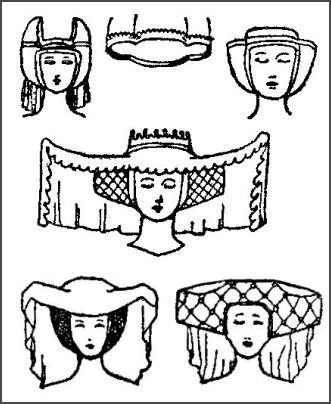
For the box pattern it is necessary to make a box, let us say of octagonal shape, flat before and behind, or slightly curved; cut away the side under the face, or leave but a thin strip of it to go under the chin.
Now stuff your box on either side of the face and cut away the central square, except for 3 inches at the top, on the forehead; here, in this cut-away piece, the face shows. You will have made your box of buckram and stuffed the wings of it with tow; now you must fit your box to a head and sew linen between the sides of the head and the tow to hold it firm and make it good to wear. You have now finished the rough shape, and you must ornament it.
Take a piece of thin gold web and cover your box, then get some gold braid and make a diaper or criss-cross pattern all over the box, leaving fair sized lozenges; in these put, at regular intervals as a plain check, small squares of crimson silk so that they fit across the lozenge and so make a double pattern.
Now take some gold wire or brass wire and knot it at neat intervals, and then stitch it on to the edges of the gold braid, after which pearl beads may be arranged on the crimson squares and at the cross of the braid; then you will have your box-patterned head-dress complete.
C15th Horn Headdress
It remains for you to enlarge upon this, if you wish, in the following manner: take a stiff piece of wire and curve it into the segment of a circle, so that you may bend the horns as much or as little as you will, fasten the centre of this to the band across the forehead, or on to the side-boxes, and over it place a large wimple with the front edge cut.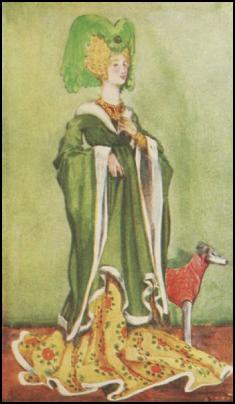
Again, for further enhancement of this delectable piece of goods, you may fix a low gold crown above all - a crown of an elliptical shape - and there you will have as much magnificence as ever graced lady of the fifteenth century.
A WOMAN OF THE TIME OF HENRY VI -1422-1461
Her head-dress is very high, and over it is a coloured and jagged silk wimple, a new innovation, being a change from the centuries of white linen wimples. Her waist is high, after a long period of low waists.
September 28, 1443, Margaret Paston writes to her husband in London
'I would ye were at home, if it were your ease, and your sore might be as well looked to here as it is where ye be now, liefer than a gown though it were of scarlet.'
My dear diplomatist, I have forgotten if you got both your husband and the gown, or the gown only, but it was a sweetly pretty letter, and worded in such a way as must have caused your good knight to smile, despite his sore.
And what had you in your mind's eye when you wrote 'liefer than a gown though it were of scarlet'?
It was one of those new gowns with the high waist and the bodice opening very low, the collar quite over your shoulders, and the thick fur edge on your shoulders and tapering into a point at your bosom.

 You wanted sleeves like wings, and a fur edge to the bottom of the gown, besides the fur upon the edges of the sleeves - those quaint sleeves, thin to your elbows, and then great and wide, like a foresail.
You wanted sleeves like wings, and a fur edge to the bottom of the gown, besides the fur upon the edges of the sleeves - those quaint sleeves, thin to your elbows, and then great and wide, like a foresail.
I suppose you had an under-gown of some wonderful diapered silk which you thought would go well with scarlet, because, as you knew, the under-gown would show at your neck, and its long train would trail behind you, and its skirt would fall about your feet and show very bravely when you bunched up the short upper gown - all the mode - and so you hinted at scarlet.
Now I come to think of it, the sleeve must have been hard to arrive at, the fashions were so many. To have had them tight would have minimized the use of your undergarment; to have had them of the same width from elbow to wrist would not have given you the newest of the new ideas to show in Norfolk; then, for some reason, you rejected the bag sleeve, which was also in the fashion.
A Cotehardie
No doubt you had a cotehardie with well-fitting sleeves and good full skirts, and a surcoat with a wide fur edge, or perhaps, in the latest fashion of these garments, with an entire fur bodice to it. You may have had also one of those rather ugly little jackets, very full, with very full sleeves which came tight at the wrist, long-waisted, with a little skirt an inch or so below the belt. 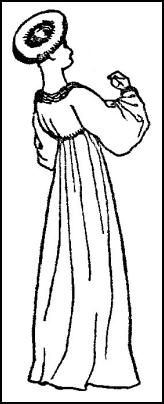
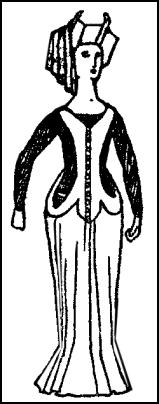
A mantle, with cords to keep it on, I know you had. Possibly - I have just thought of it - the sleeves of your under-gown, the tight sleeves, were laced together from elbow to wrist, in place of the old-fashioned buttons.
I wonder if you ever saw the great metal-worker, William Austin, one of the first among English artists to leave a great name behind him - I mean the Austin who modelled the effigy of Earl Richard Beauchamp, at Warwick.
You must have heard the leper use his rattle to warn you of his proximity. You, too, may have thought that Joan of Arc was a sorceress and Friar Bungay a magician. You may have - I have not your wonderful letter here for reference - heard all about Eleanor of Cobham, and how she did penance in a shift in the London streets for magic against the King's person.
Some ladies, I notice, wore the long-tongued belt - buckled it in front, and then pushed it round until the buckle came into the centre of the back and the tongue hung down like a tail; but these ladies were not wearing the high-waisted gown, but a gown with a normal waist, and with no train, but a skirt of even fulness and of the same length all the way round.
There were striped stuffs, piled velvet, rich-patterned silks, and homespun cloths and wool to choose from. Long-peaked shoes, of course, and wooden clogs out of doors.
Everyone Else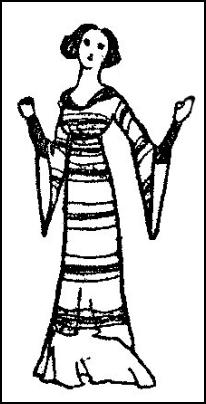

The town and country maids, the merchants' wives, and the poor generally, each and all according to purse and pride, dressed in humbler imitation of the cut of the clothes of the high-born, in quite simple dresses, with purse, girdle, and apron, with heads in hoods, or twisted wimples of coarse linen.
Well, there you lie, ladies, on the tops of cold tombs, stiff and sedate, your hands uplifted in prayer, your noses as often as not knocked off by later-day schoolboys, crop-headed Puritans, or Henry VIII's sacrilegious hirelings. Lie still in your huge head-dresses and your neat-folded gowns - a moral, in marble or bronze, of the pomps and vanities of this wicked world.
HENRY THE SIXTH
Reigned thirty-nine years: 1422-1461.
Born 1421. Dethroned 1461. Died 1471. Married, 1446, Margaret of Anjou.
- A MAN OF THE TIME OF HENRY VI - 1422-1461
-
A WOMAN OF THE TIME OF HENRY VI -1422-1461

 This costume history information consists of Pages 176-197 of the chapter on the 15th century dress in the 39 YEAR REIGN era of Henry The Sixth 1422-1461 and taken from English Costume by Dion Clayton Calthrop.
This costume history information consists of Pages 176-197 of the chapter on the 15th century dress in the 39 YEAR REIGN era of Henry The Sixth 1422-1461 and taken from English Costume by Dion Clayton Calthrop.
The 36 page section consists of a text copy of the book ENGLISH COSTUME PAINTED & DESCRIBED BY DION CLAYTON CALTHROP. Visuals, drawings and painted fashion plates in the book have a charm of their own and are shown amid the text. The book covers both male and female dress history of over 700 years spanning the era 1066-1830.
This page is about dress in the reign of King Henry The Sixth 1422-1461. The images and details are a good resource for costuming Shakespearean stage plays of the Plantagenet era.For the Introduction to this book see this introduction written by Dion Clayton Calthrop. I have adjusted the images so they can be used for colouring worksheets where pupils add some costume/society facts.
My comments are in italics.
You have been reading English Costume History at www.fashion-era.com © from the chapter Henry V 1422-1461 from Dion Clayton Calthrop's book English Costume.
Page Added 5 August 2010. Ref:-P799.
NEXT - EDWARD THE FOURTH - 1461-1483
Sitemap
For more information about English Costume By Dion Clayton Calthrop
see these pages:
- Costume History Home
- Introduction to English Costume by Calthrop
- 1066-1216 Norman
- 1272-1485 Plantagenet
- 1216-1272 Henry III
- 1066-1272 Peasants' Costume - End of the Fourteenth Century
- 1272-1307 Edward I
- 1307-1327 Edward II
- 1327-1377 Edward III
- 1377-1399 Richard II
- 1399-1413 Henry IV
- 1400 Chaucer's Medieval Dress
- 1413-1422 Henry V
- 1422-1461 Henry VI
- 1461-1483 Edward IV
- 1483-1485 Richard III
- 1485-1603 Tudor
- 1603-1714 Stuart
- 1603-1830 Hanover
- Chambre Syndicale
- Theories of Fashion

